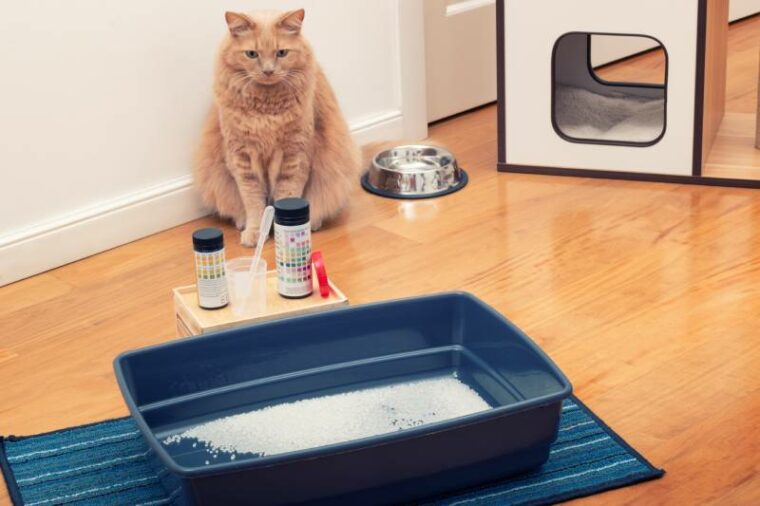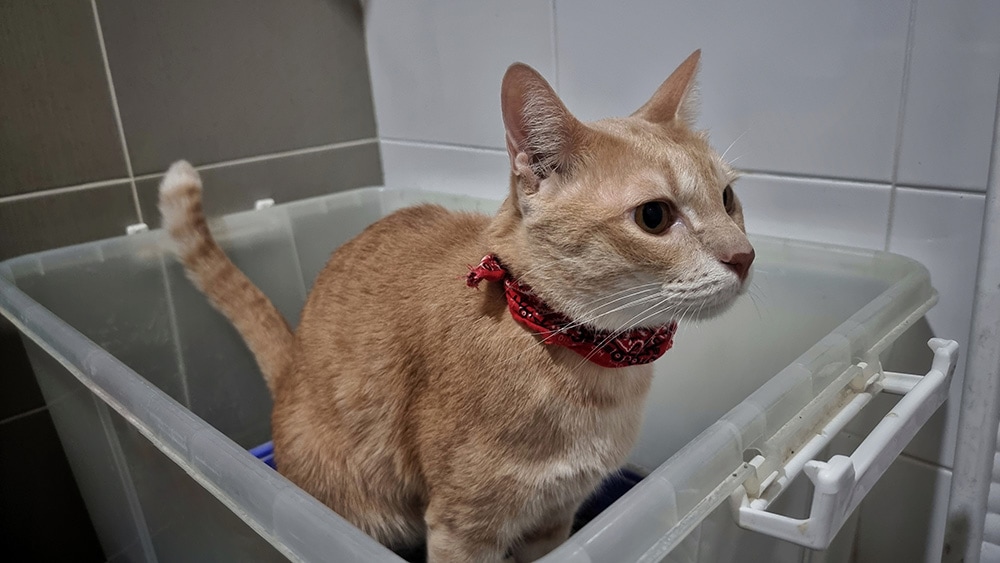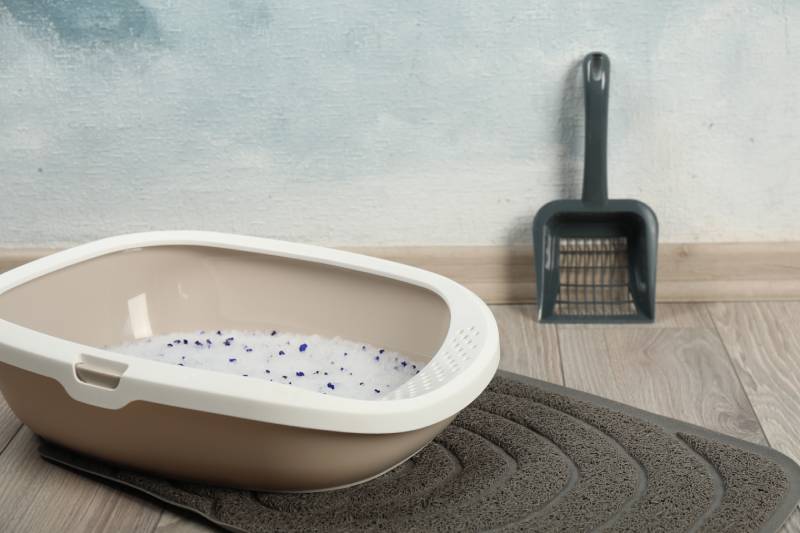
If your cat hasn’t been well, your vet may ask you to get a urine sample from your cat. You may have had to provide a urine sample for your doctor at some point, and the vet may require one for the same purpose. A urine sample can offer vets a lot of information about your cat’s health and can give an indication of what is wrong.
The vet will examine the color and appearance of the urine, as well as the microscopic appearance, and also perform chemical tests. The results can indicate that all is fine or that something isn’t right, which will lead your vet to test your cat for more specific health problems. Unfortunately, cats don’t provide urine samples on command, so it’ll be up to you to collect one and give it to the vet. We’re here to help you with some expert tips and tricks.
Preparation
Getting your cat’s urine sample isn’t as tricky as it sounds as long as you use items that help you with the process. Unlike humans, cats aren’t expected to “pee in a cup” and can urinate where they usually do. Once they’ve done their business, you’ll come along and collect the sample to place it into the sample pot that is usually provided by the vet.
The items you’ll need to make this process as easy as possible are:
The 7 Tips How To Collect Your Cat’s Urine Sample
Your vet may ask you to collect a urine sample from your cat at home. However, if you are struggling to get a sample for whatever reason, phone your vet and let them know. They may be able to do this for you at the veterinary clinic instead. Ask your veterinarian if there are any special instructions for how the urine needs to be collected or stored.
1. Find Out When the Best Time Is
Your vet might be happy with any urine sample, regardless of the time of day you got it. However, some may want you to collect it first thing in the morning. The first pee is usually preferred because your cat will have a full bladder, and they wouldn’t have had anything to drink yet, which means the urine would be most concentrated. As your cat drinks water throughout the day, their urine becomes less concentrated, which could produce results that aren’t as clear when the urine is tested.

2. Get Everything Clean
It’s important to clean all the items you’ll be using to collect your cat’s urine sample to avoid contamination that could result in inconclusive or inaccurate test results. The sample you get won’t be sterile but cleaning your cat’s litter tray before you want your cat to urinate in it for the sample will keep it free from hair, dirt, and feces.
Remove all the old cat litter from the tray and wash it with hot, soapy water. You can then leave the tray to dry. Make sure that all the other items are clean too.
3. Prepare the Litter Tray
Your cat will need to urinate in their litter tray for you to collect their sample. However, you won’t be able to use their usual cat litter because it is absorbent, which is the opposite of what you want in this situation. Instead, you can use non-absorbent cat litter from the vet or your local pet store. What’s nice about this cat product is that it is reusable if you wash it thoroughly and store it correctly.
If you would prefer to use materials that you have at home, you can shred up plastic shopping bags. However, some cats will refuse to use their litter tray without cat litter, so test which option works best for your cat.
You’ll want to place some type of “litter” inside the litter tray for your cat to paw at to cover their urine, as this is a natural instinct. However, it shouldn’t absorb the urine but rather leave it behind so that you can collect it once they’re done.

4. Isolate Your Cat
Collecting a urine sample can become tricky if you have more than one cat sharing a litter tray, as you don’t want a situation where you give your vet the wrong cat’s urine or a mixture of urine. Instead, you may need to isolate your cat by placing them in a room that another cat won’t be able to enter. Be sure to leave the prepared litter tray in the room with them and check on your cat often, allowing them out as soon as they’ve urinated.
Isolating your cat in a quiet room with their litter tray may also be necessary if they like to pee outside or if you need to collect the urine at a specific time of day.
5. Collect the Sample
Once your cat has urinated, you’ll need to collect it. Be sure to do this soon after to avoid contamination. You don’t want to affect the results of your cat’s urine sample in any way, so if your cat also passed feces and it’s been sitting in their urine, you’ll need to discard the contents of your cat’s litter tray, wash it, dry it, and try again.
You can lift one side of your cat’s litter tray to pool all the urine together to make it easier to collect. Either use a dropper or a syringe to suck up the urine and transfer it to the sample pot that your vet provided you with. Be sure to secure the lid tightly.
You can use gloves to carry out this process, but if you don’t have any, make sure to wash your hands thoroughly after working with the litter tray and the urine sample.

6. Label the Sample
Your vet likely receives several urine samples every day, and you don’t want your cat’s sample getting lost or mixed up with another pet’s. Make sure that you use a pen and label your cat’s urine sample before dropping it off at your vet. On the sample pot, you’ll need to write down your cat’s name, your name, and the time and date that you collected the urine sample.
7. Get the Sample to the Vet
Once you’ve labeled the sample pot, try your best to get it to your vet as soon as possible. The sooner you take it to be tested, the more accurate the results will be, as old urine can develop crystals and will have more bacteria.
It is recommended that you take it to your vet within 2 hours of collecting the sample. However, if this isn’t possible, store it in the fridge until you are able to take it to the vet. After 24 hours in your refrigerator, you will need to discard the urine sample and collect a fresh one from your cat.

What Do Urine Samples Diagnose?
A urine sample is often the first step in diagnosing an underlying health problem and is often followed by other tests if something doesn’t look right. Vets check the concentration, glucose, protein, blood, and inflammatory cells in the urine sample to find out valuable information about your cat’s health. The urine sample is commonly used to help diagnose health conditions such as:
Conclusion
If your vet asks you to collect your cat’s urine sample at home, don’t worry, you can do it in seven easy steps! To make sure your vet is able to get the most accurate results from the sample, you need to make sure that all the items you use throughout the process have been washed and dried. You also need to make sure it doesn’t get cross-contaminated or left for too long before being dropped off at the vet.
Most vets prefer testing your cat’s first urine in the morning as this is when it’s most concentrated, so check with them to make sure. Also, ask them for a sample pot, as this will make storing and delivering the sample much easier.
Featured Image Credit: Yaya Photos, Shutterstock







